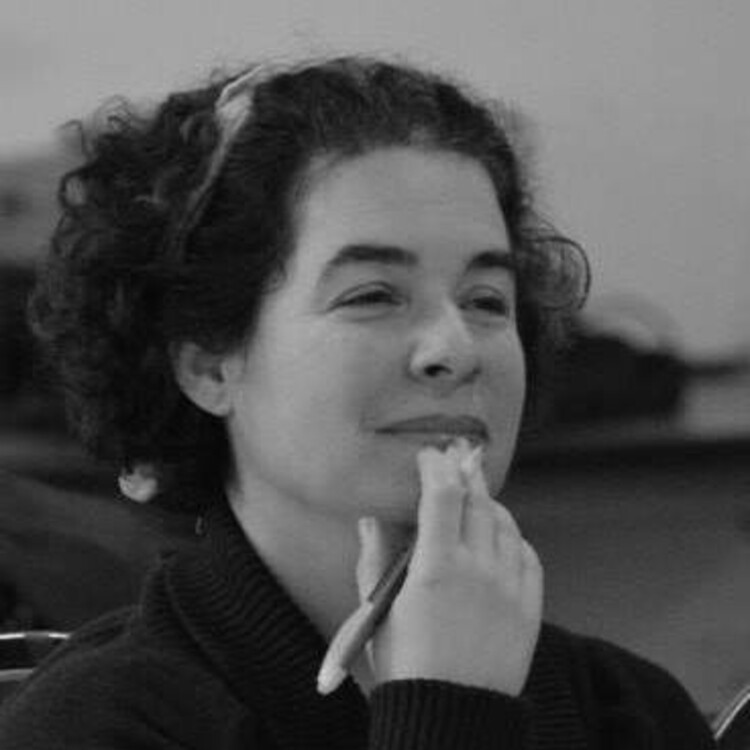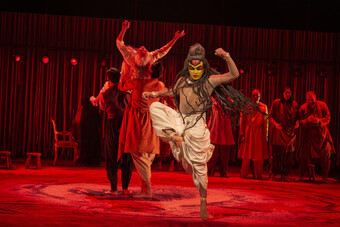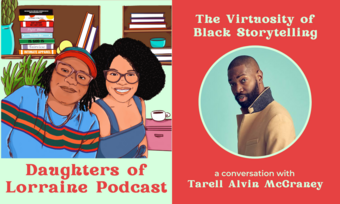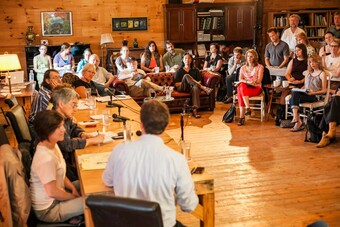The Importance of Beginning
The Changing Relationship of Artists, Organizations, and Communities
This essay is adapted from the version that appears in Counting New Beans: Intrinsic Impact and the Value of Art. This book includes the final report from research firm WolfBrown on their two-year study "Measuring the Intrinsic Impact of Live Theatre," as well as twenty-four interviews with artistic leaders and patrons, and essays by Diane Ragsdale, Arlene Goldbard, Clayton Lord, and Rebecca Novick—plus a foreword by Ben Cameron of the Doris Duke Foundation.
We’re living through a major shift in the way people make and consume culture, one that we can’t yet see the end of. Theater institutions must respond to this change or face increasing irrelevance. So, what is essential to theater-making and what can be discarded? What is the particular value of live performance? And, if you’re an artistic director who wants to shift your relationship with your audience, where should you start?
As part of Theatre Bay Area’s intrinsic impact study, I interviewed twenty artistic leaders representing a wide variety of theaters with diverse budget sizes, programming, and geographic location. All of them were passionate, smart leaders, all grappling with how to find relevance and sustainability in the midst of major change.
Most of the artistic directors I interviewed were deep believers in the transformative possibilities of the ordinary theater experience. In fact, the intrinsic impact study was designed specifically to measure the ways in which watching a live performance can create long-lasting impacts on an audience member. But what if these impacts aren’t enough–-or aren’t unique to live performance? What if the real social impact theaters often claim to be accomplishing is simply not happening in traditional contexts?
Recently, the James Irvine Foundation announced that it would shift the majority of its support to projects that expand how Californians engage actively in the arts “by making or practicing art.” In a report on the subject for the Irvine Foundation, Alan Brown (the same researcher who conducted this intrinsic impact study) writes:
People are thinking about the experience of culture differently than in the past, placing value on a more immersive and interactive experience than is possible through mere observation…. Increasingly, Americans want to meet the people who make our products, share in the work of the makers and make things ourselves.
Does this signal the beginning of a de-investment by funders in the presentation of conventional plays in conventional venues? Is the implied suggestion here that we should never do a conventional production of Hamlet again? For Michael Rohd, these questions arise from what he sees as a lack of sophistication in the theater industry around this topic. Rohd is the artistic director of Sojourn Theater, and in his mind, “Everything is changing—all the notions of co-authorship and collaboration and what ‘participation’ even means.”
Rohd was at the 2010 Theatre Communications Group conference participating in a discussion about participation when a person who runs what he called a “traditional regional theater” in Chicago offered a definition, “What participation means to me is when people lean forward in their chairs.” Rohd’s reaction was strong: “I was like, ‘You know what? The rest of the art world—other disciplines—think we're children when we talk like that. We just seem like children.’”
In his work, Rohd always has both artistic aims for a project and goals around a specific kind of exchange or dialogue that he is trying to create. Rohd has aimed for “an audience experience that allowed them to feel and observe the value of the work as an artistic experience but also…as an applied model.”
For Rohd and the company of Sojourn, the idea that theater can serve as a spur to encourage deep dialogue around community issues has always been integral to the work. By including communities in the shaping of work and designing the context for seeing their productions, Sojourn has created a community conversation that reaches past convening a supplemental panel after the play or getting people to argue about the issues a play raises on the way home.
Rather than holding aspects of the theater form sacred, Rohd and his team continually explore how a professional theater company can use different modes of participation to engage audiences while still “putting on a show.” That said, Sojourn, by design, is compact, nomadic, and efficient, which in part allows them to take on such challenges. For artistic directors at larger institutions, it can be trickier to figure out how to shift to a more participatory mode—but it’s becoming increasingly essential that they do.
Ben Cameron, former director of TCG and now head of arts funding at the Doris Duke Charitable Foundation, likes to compare the current culture shift with the Protestant Reformation. He parallels that with the current advent of various technologies that are allowing for an un-intermediated engagement between the art and the individual—YouTube videos, “concert-quality” sound through headphones, higher-quality on-demand television, and movies. Who needs an institution in that world? As Cameron says, the Reformation was not a great time to be monastery.
For Rohd, this translates to moving beyond “leaning forward in your chairs” towards engaging in discussion before and after the work and even towards participating in the unfolding of the performance event:
There's interpretation: that's the leaning forward and engaging in participation by interpreting your own experience. Then there’s commentary: that’s being given technological tools to be involved in discourse around the event either during it or before and after. And then there's impact: that’s layers of participation where you impact dramaturgically what happens in the trajectory of the event. The other fields are past number one, and they’ve been practicing number two for years. Number three is where the real action is.
Not every theater wants to (or should) focus on devising community-based work or creating work with explicit political aims. However, many theaters are beginning to take some steps towards a more inclusive, open, democratized way of working. If we want more theaters in the field to begin to change, we must chart these early steps and acknowledge the importance of beginning.
This won’t look like never doing Hamlet again, but it may look like telling stories from other traditions as well, developing new work in concert with the communities we hope to engage, gradually blurring the lines between professional and amateur, and creating other programs that receive as much focus and investment as the performance of classic plays by professional artists.
At Woolly Mammoth Theatre Company in Washington, DC, Howard Shalwitz and his staff are several years into a deep exploration of engagement. This work, funded by the Doris Duke Charitable Foundation (who also was a major funder on Theatre Bay Area’s intrinsic impact research), began several years ago. Shalwitz, among other things, designed a new position he calls “connectivity director” that is tasked with creating new ways to engage audiences with the work of the theater.
“We’re in a state of evolution about how we think about our role in relation to our audience,” Shalwitz explains. “We’re still working from our historical emphasis on challenging our audience, but with an increasing emphasis on trying to do plays that connect with pressing conversations that are happening in our community.”
Rachel Grossman (who was, at the time of this interview, Woolly’s first connectivity director) elaborates: “The big picture idea, of course, is to ask, ‘What is the role of theater in our community and in this city?’ What conversations are actually happening among people now, and how Woolly can participate actively? How we can be a hub for civic discourse that is already occurring?”
Each artistic director employs a different balance between letting artists lead and choosing artists who connect to issues the theater is interested in exploring. Diane Paulus at the American Repertory Theater (ART) has begun seeking artists who can jumpstart dynamic engagement around issues:
[I’m] always looking for artists that have, in a way, that larger question they're asking. That’s the kind of work I gravitate to. Like Steven Sater, with Prometheus Bound, who sends me his translation of this Greek play and says, “Prometheus is the first prisoner of conscience.” Artists that think that way lead to these kinds of moments. So it's always looking for an artist who is going to have a larger worldview on their work.
Thinking about how to engage audiences in grappling with the ideas of the play, she forged a partnership with Amnesty International. The ART adopted different human rights cases and presented them to audiences at performances of Prometheus Bound. After each performance, audiences were invited to stay, learn more from Amnesty staffers about that evening’s case, and participate in a postcard signing campaign. Paulus concludes:
To me, it's exactly what you hope for from the theater. You don't hope that you make a theater event, and then the ushers ask you to leave, and then that's the end of it. You work very hard in a theatrical way to transform an audience so that the next thing can happen.
Woolly Mammoth staff go one step further, explicitly asking playwrights, “Who do you imagine is the audience you want to be talking to with this play?” This is what they call “audience design,” which Rachel Grossman describes as “filling out, shaping out, finishing the audience, if you will, as an artistic gesture of the show.”
The idea of reaching out to particular communities for particular plays may not sound like any kind of radical participation model—until you start thinking about how few people really do it.
Engaging the playwright in this type of conversation can have surprising effects, as it did with Robert O’Hara, a gay African-American writer whose play Booty Candy was part of Woolly’s last season. Booty Candy was comedic, but also challenging and confrontational, and Shalwitz and Grossman figured that O’Hara would simply want the piece to speak to the gay African-American community of Washington, DC. Instead, as Shalwitz says, “Robert said something very, very surprising. He said that he wanted to talk to black churchgoers. He wanted to talk to the unconverted part of his community—the people that weren’t comfortable with all of these images of black gay men dealing with their history and identity questions.”
This was a transformative moment for the staff, he explains, and ended up having a significant effect on the way the show was marketed and what kind of supplementary programming they created.
The idea of reaching out to particular communities for particular plays may not sound like any kind of radical participation model—until you start thinking about how few people really do it. Given the grave mismatch between the demographics of most theater audiences and the demographics in the surrounding community, this approach can jumpstart efforts to diversify audiences and, at a minimum, shift the organization away from feeling responsible only to a narrow group of long-time patrons.
Jack Reuler at Mixed Blood Theatre in Minneapolis agrees: “Traditional marketing says you try to get somebody in the door and then you try hard to get them to come back. We said, ‘What if we put that on the back burner and say, Who’s this play for? Let’s find them.” Since he programs a variety of shows aimed at different communities, Reuler measures his success in terms of reaching the people the show is about, and doesn’t worry as much about whether those people attend his other programming.
This year, Mixed Blood has made an even stronger commitment to their vision of “revolutionizing access” by making all of their shows free of charge, a project they call “radical hospitality.” It’s too early to tell exactly what effect this will have on who comes to their work or how sustainable the plan will be for the theater, but it’s a powerful evolution for a theater that already leads the field in efforts to reach diverse audiences and an interesting experiment in determining how much cost is truly a barrier to inclusion.
At Roadside Theater, developing plays and developing the audience for them have always gone hand in hand. Based in Virginia, Roadside was founded in 1975 with the aim of telling the stories of Appalachia “from the inside out,” in the voices of the community. Their play development processes engaged the local community deeply, and brought the people to see the shows whose stories were being told on stage. However, when the company began to tour its work, it became challenging to ensure that presenting theaters had the tools to attract the kind of diverse working-class audience the work was made to play in front of.
Roadside collaborated with Junebug Theater (an African-American theater in New Orleans) to create Junebug/Jack, a play exploring the historical relationship between the black and white working classes in the South. Cocke explains the challenge they faced on tour:
So, the trick, for us while on tour, was how in the world are we going to get black and white working class people to come to the play? And if we don't get black and white working class people to come to the play, haven't we defeated the play’s purpose?
After some experimentation, they settled on the tactic of requiring that a theater that wanted to present the play had to create an ecumenical choir, inviting participation from both black and white churches. Roadside sent the show’s music to the choir ahead of time, then rehearsed with them for a few days after the touring troupe arrived. This choir, Cocke explains, would end up sounding different than anything the community had heard before because these voices had never been heard together before, and by the time the show opened, all different communities were in the audience because they wanted to support their friends and see this new choir they kept hearing about. This elegant solution helped create the audience that could best appreciate the play, and helped set up a new kind of conversation about race after the performance that could never have occurred just by watching the play.
When the ART recently produced The Gershwins’ Porgy and Bess (with revised book by playwright Suzan-Lori Parks), the project provided an opportunity for an unusually comprehensive set of educational activities surrounding the show asking (as Paulus frames the question), "How do we make this not just about the art on the stage but rather a point of departure to discuss African-American history, issues of race and representation in art, culture meets politics in American 20th century history?" The ART created a city-wide seminar on this set of topics with activities ranging from classes in high schools and colleges, lectures in a variety of community venues, and even dinner parties in the homes of audience “ambassadors” featuring combinations of Jewish and African-American cuisine along with the opportunity to discuss the production.
Enhanced engagement activities can also begin to carefully blur the lines between professional artists and “civilians.” Shalwitz describes how they have begun to shift the content of their post-show talkbacks away from discussions of craft and towards a discussion of the issues underlying the play. It’s important, he adds, for the artists participating in these talkbacks to be asked to respond to the play as themselves, as people in the world like the audience, rather than as experts: “We've been using the phrase ‘a citizen artist.’ You're trying to value their participation, not just as a craftsperson but as a human being. For example, in the post-show conversations around Clybourne Park that included actors, the actors were asked to talk about their neighborhoods in relation to the content of what's in the play. That's an evolution.”
This way of working is profoundly democratizing, demonstrating that we each come to a play with our own ways of receiving and interpreting it, and that each of us has something to share with others that might deepen their experience.
This language (citizen-artist, citizen-witness) helps shift our perspective, agreed Dudley Cocke, who also uses the phrase “citizen-artist” to refer to community members who participate in creating or performing Roadside’s work. At Cornerstone in LA, they use the lovely phrase “first-time artists” to refer to the community participants that almost always play roles in their productions.
At Roadside Theater, “enhanced engagement” has evolved into a method that extends the development of a piece into the conversations that happen with audiences after a performance. Instead of talkbacks, Roadside uses story circles to follow performances, inviting audiences to share their own stories that were called up by the show. These stories often help actors deepen their roles, or find their way into a revision of the play. This back-and-forth connection with the audience is part “of the DNA” of Roadside Theater and essential to the work they’re attempting to accomplish:
When one of our plays is successful, it takes you into different places, intellectually, emotionally, and spiritually, and with that experience, the stories that then come out in the audience circle are very, very rich. At such moments they—the audience—realize their own potential as artists and as shapers of narratives. And that idea of animating and empowering the community voice is why Roadside…got started in the first place.
Space also plays an essential role in shaping audience participation. Sojourn’s shows are all site-specific, with location being integral to the experience they are trying to create. In her few years as artistic director at the ART, Diane Paulus has received tremendous notice for her radical experiments with space. After a wildly successful run of The Donkey Show (a Midsummer adaptation) in a club space, Paulus began to consistently program work in alternate spaces, including the U.S. premiere of Sleep No More by the British group Punchdrunk, an immersive piece that asks audiences to don masks and chase actors through the space as each audience member decides for themselves which Macbeth character they’re interested in following. Lines between audience and performers easily blur, entering and exiting is informal, and audience members can shape their own participation.
Imagine for a moment a theater where conversation back and forth with the performers was allowed and expected, a theater where you could move freely around the space and decide what angle to watch from, a theater that perhaps you paid nothing to attend. Imagine that you or some people you knew had been part of story circles that generated the material for the performance, and that you were invited to share stories from your life that connected to the play after you watched.
Cocke describes the moment he knew Roadside had really become part of the community it was trying to serve: “Out of the blue, we got a call from a woman asking us to please come and sing several of the songs from one of our play’s at her dad’s funeral. Then we knew our theater had become part of the community’s daily life.” There’s a democratizing wind blowing through our culture and a growing sense that everyone deserves the opportunity to be a maker. Theater institutions can be part of making that possible, or they can continue to be gate-keepers, deploying their formidable resources on behalf of just a few anointed artists, performing in front of ever-shrinking audiences. Transformation is happening all over the arts sector, and I hear the beginnings of change in larger theaters. Let’s identify and celebrate these early moves towards a more participatory theater while continuing to reach for deeper change.














Comments
The article is just the start of the conversation—we want to know what you think about this subject, too! HowlRound is a space for knowledge-sharing, and we welcome spirited, thoughtful, and on-topic dialogue. Find our full comments policy here
This post is a great service, Rebecca. I wish we spent as much time in discussions (both within and outside of our own institutions) figuring out how to make our audience interactions work as we do figuring out how to make the productions work. Thanks for helping reveal how much fun it can be—just another important part of the artistic/creative process.
This is quite an amazing offering. Very meaty. I was particulary inspired and moved by the section on 'Roadside', and developing ways for the community to contribute their stories, and how that fed the evolution of what they were offering. There are some memorable moments in my life where the 'theatre' of hearing the sharing of 'stories' created deep impact. I also found the section on how certain theatres used the question of 'who do we want this play to be seen by' and creating marketing around that quite valuable. I also felt frustrated at times during the first half of the article because I felt several comments were grand, sweeping statements that did not include specifics examples or actions which would illustrate their perspective. Re: 'By including communities in the shaping of work and designing the context for seeing their productions . . .' There is no mention of how the community has specifically helped shape the work and design the context for seeing their productions. Re: 'Rohd and his team continually explore how a professional theater company can use different modes of participation to engage audiences while still “putting on a show.” What are these different modes? (inquiring minds want to know) Re: 'YouTube videos, “concert-quality” sound through headphones, higher-quality on-demand television, and movies. Who needs an institution in that world?' I don't feel this is a good analogy, they are totally different mediums. Yes technology is and will continue to develop in all artistic fields, including theatre, (the use of projections and video is one example). A lighting designer friend of mine recently returned from a theatrical lighting seminar and said it was amazing and awesome with what was being created for theatrical use (also awesomely expensive). As advantageous and supportive as technology may be, including its use in the theatrical art form, the main attribute that has always set theatre apart from other forms of performance has been its 'living bodily presence'. Re: 'developing new work in concert with the communities . .' Besides the specific example of Roadside, I would be interested in hearing more ideas from others about this aspect of creating meaningful theatre through engagement with the community. I would also like to point out that this does not negate the importance of the voice of the singular playwright. The example of ART engaging audiences at performances of Prometheus Bound with presentation of different human rights cases was ever so cool, and a wonderful specific example of interesting community engagement. Re: Mixed Blood making all their shows free of charge. Really? Is it all performances of all shows, or only selected ones. I can't imagine a theatre staying open for long with all free performances. I have mixed feelings about this. Yes, there definitely are significant portions of the population that cannot afford theatre tickets. Are you kidding, I can hardly afford them. How many of these individuals find it important enough to come up with $13 to see a movie though? My point is (a) Doing free shows is a wonderful way to provide a 'give back' to the community, and it should be carefully planned and structured with appropriate boundaries because (b) people have a tendency to be more invested in the value of something they are receiving when they are investing in it. In this culture that's usually cash. Well . . . credit. Now it may behoove us to discover a different form of "investment". That would be an interesting conversation. Re: 'At Cornerstone in LA, they use the lovely phrase “first-time artists” to refer to the community participants that almost always play roles in their productions.' I'm not saying there isn't a place for this in theatre - it could be very rewarding for the community and beneficial for the production. And while there have been times when I've seen professional actors where I've wondered how they ever got their Equity card, there is usually a big difference between a trained, experienced, professional actor and a 'first-time artist.' Re: 'site-specific venues for plays - and U.S. premiere of Sleep No More.' I do think we will be seeing increasing site-specific theatre. I did not see Sleep No More, but the few friends who did all said it was one of the most amazing theatre experiences they have had. However, for many established theatres with established structures, site-specific programs I would imagine would be the special and unusual endeavor they do once a season or every other season rather than the norm. I would imagine a more practical exploration would be how to renovate our theatres in such a way to make them for flexible in the way theatrical offerings are presented - even allowing them to be utilized in such a way where audience members could travel to different locations to view the production (although for me if that occured too often during a production I as an audience member would find it annoying or distracting unless it was a 'walking audience' presentation like Sleep No More. Re: Imagine for a moment a theater where conversation back and forth with the performers was allowed and expected . . .' Ah, do you mean the audience speaking to the performers? Unless the design and structure of the piece includes that as it's form . . . I don't think so. Now if we're talking about the performance being so arresting, so disturbing, so "something" that as an audience member I have the feeling of personal freedom to express that feeling or thought out loud i.e., "How could you do that," "Yeah, get him, knock his f----ing teeth out," "I think I'm going to be sick," I suppose it would be good for me as a performer (I am) to be flexible enough to flow with the experience, and hopefully discern if it's just some ass being narcistically disruptive or a genuine outflow from the play affecting him. So many considerations here however, like the years it would probably take for audiences to not be disrupted by such verbal expression let alone feel comfortable enough to engage in them. However, if you're suggesting some kind of exchange within the experience of theatre where the actor and audience member(s) spontaneously engage in conversation? I can hardly believe you'd be advocating that. It would be totally disruptive to the flow and build of the story being enacted. I would have appreciated more clarification regarding that comment as it could be interpreted so many ways. It may seem I'm harping at bit here on specifics, but specifics is what can stoke the fire of passion (for an idea or goal) with greater clarity. I also put forth a call and reminder to those who read these pages on HowlRound that while there is indeed a shift and transition occuring in how the arts are created and how the community engages with that creation, there is a difference between jumping on the bandwagon of novelty (our world is addicted in many unhealthy ways to novelty for noveltie's sake because our minds are restless, chaotic, confused, and contain the belief that we need external stimulus to find satisfaction) and endeavoring to discover and create ways to penetrate into and support greater understanding of what we as individuals, community, and species require for wholeness. The creative act of art making at its highest if 'wayshower'. There is somehting magical, something mysterious, about the simplicity of sitting in the dark and hearing a story, being washed over by it, penetrated by it, and needing to know immediately how you've been affected, but trusting, and on some level know that you have been. From early days around the campfire to the darkend sanctuary of the theatre this has existed. I am less concerned about the advancements of interactive forms between audience and community (but I support them) than I am with the continuance of recognizing storytelling as a sacred act. That the stories be worth the telling.
Excellent suggestions and pertinent topic, especially in rural states where diverse groups often live and work closely together; sharing the challenges of such new approaches to theater production could expand empathy and encourage revelation. Such community dialogue can't be forced by news coverage, political panels and church study circles. Thanks for this article!
This is absolutely f*cking brilliant! How the creators of Junebug/Jack got a specific audience to come, for one. __ I saw "BootyCandy," and knowing that Robert O’Hara wanted black churchgoers to see the show gives me a whole new perspective on the play.